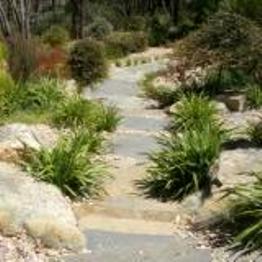|
Water Wise LandscapingUsing a Water Wise approach to your garden or landscape is a key part of green living. The use of water in the landscape does not need to be wasteful, rather it is an important use of our water resources. When many people hear the term Xeriscape or Low Water Use landscape, the image of rocks and cactus comes to mind – but nothing is further from the truth. With good planning and carefully following a few important guidelines, it is very possible to have a creative, beautiful landscape while using a minimal amount of water. Let’s get started!

First, make sure to group plants with similar water needs together. Some plants need more water – so group them with each other and make sure to place them in a location that is protected from the wind. A big part of water wise landscaping is using the plants in the right place. Choose appropriate plant materials. A lot of people focus around the term “drought tolerant plant”, but it really comes down to the right plant in the right place. Use your higher water use plants in tighter protected areas, while the plants that need less water can form your screens and cover a lot of area. Next, think appropriate lawn areas. It is very difficult to efficiently water a lawn on a slope – so use a different ground cover there. Very narrow areas are also difficult to water, as are very windy locations. Choose your turfgrass varieties carefully. There has been great progress in the past 10 years in developing some very attractive grass varieties that use less water. Your local Agricultural Extension office can be a great source of information on these newer varieties. Appropriate turf areas can certainly be a part of a water wise landscape. Prepare your soil thoroughly. The deeper you can get the roots to go, the longer your plants can go without water. Deep rooting means you must create a deep soil environment to allow the roots to penetrate. You also need for the soil to absorb water without running off so your plants are able to benefit from the water. Your soil is unique, so again your local resources are the best bet for a recommendation.
Use mulches to reduce water loss from evaporation and to insulate the soil. This is especially important in hot, arid climates. Mulch helps keep the roots cool, conserves moisture, and prevents weeds (which use some of the water intended for your landscape plants). Plan your efficient irrigation system. Irrigation technology has come a long way in the past 10 years. The key is getting the right amount of water to the plants, avoid watering non planted areas, and applying the water at a rate that can be absorbed by the soil. Low flow sprinkler heads, drip or trickle irrigation, and smart time clocks all help create the efficient irrigation system.
Keep your sprinkler system tuned. Just like an out of tune car wastes gas, an out of tune sprinkler system wastes water. Check your system for broken pipes, clogged heads, bent or turned heads, and adjust your system as needed to accommodate the growth of your plants. If you have an automatic clock, make sure it is turned off when it rains – or better yet invest in a smart clock that senses rain and turns itself off! 
That wasn’t so rough was it! If you plan your landscape to be water wise from the start, it really is easy to have a beautiful water efficient yard.
Learn about landscaping with succulents here
|
